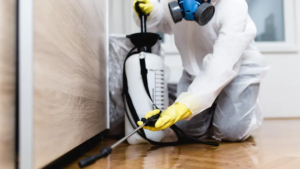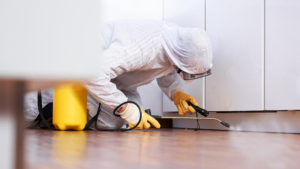Pest control includes preventing a pest from occurring, suppressing (reducing a pest population to an acceptable level), and eradicating it. Prevention and suppression are common goals in outdoor pest situations, while eradication is a goal in enclosed environments where a specific pest cannot be tolerated.
Preventative measures include removing food, water, and shelter sources for pests, storing food in sealed containers, removing garbage regularly, and fixing leaky faucets. Click https://natureshieldpestsolutions.com/ to learn more.

Pest identification is an important first step in determining the need for pest control. With accurate information on which to base a management program, any effort to control a pest will likely succeed. The key to effective pest identification is to identify the species, as different members of a family or genera may behave very differently and have differing natural enemies or habitat requirements.
It is often difficult to identify pests based on their damage, as many have very specific eating patterns and leave behind distinctive markings. Careful observation can reveal these patterns. In addition, pests typically have very different life cycle stages and will appear quite different depending on the time of year.
A good starting point for pest identification is to consult a pest identification guide. Several printed and online guides are available. Using these guides can help you determine the type of pest and provide important information such as food, environmental and harborage preferences, threats and prevention/control tactics.
Once you have determined the type of pest, you can monitor it to see how bad the problem is. Monitoring can include examining the crop, landscape, garden or building to identify which pests are present, how much damage they have caused and what their population dynamics are. In some cases, it is necessary to take samples of the pest for further examination by an expert.
Some pests are more serious than others, and the degree of damage can influence whether or not a control program is needed. Some pest problems require immediate attention, while other situations can be allowed to continue for some time before taking action.
Identifying the pest is also necessary when selecting a pesticide. Many pesticides are designed for specific insect species and will not work against other types of insects, plants or animals. Using a pesticide that is not designed for the type of pest being controlled will not only be ineffective but could also harm beneficial organisms.
Similarly, if the pest is a plant disease or an unwanted weed, identifying the specific problem can be very helpful in planning a management strategy. For example, a disease-causing fungus can be managed by removing infested vegetation, keeping garbage and compost piles away from the foundation of buildings, and making sure there is adequate drainage in basements.
Pest Prevention
Even with the best sanitation practices, buildings can still become infested with pests. A pest infestation describes any number of invasive species that cause damage to the building, have health implications for its occupants or are simply distracting and annoying. Once pests reach unacceptable levels, they trigger a reactionary response by the property owner and the pest control company.
To prevent pests from reaching that point, a proactive approach is needed. Integrated pest management (IPM) emphasizes monitoring, identification, and assessment of damage and then applying appropriate treatment methods to achieve the desired result with minimal environmental impact.
For example, a gardener might monitor their plants and note when they start showing signs of insect damage. They would then make a note to check the soil and the surrounding area for pests. This is known as scouting and can be done daily or weekly, depending on the environment. By checking regularly, gardeners can be sure to address problems early, before the pests have a chance to spread and do significant damage.
In commercial settings, pest prevention also starts with clear communication and education to ensure that all employees understand the strategies in place. For instance, keeping kitchen and bathroom areas scrupulously clean can prevent flies and cockroaches, while garbage should be removed regularly with tightly closed trash cans. Fixing leaky plumbing and reducing moisture around the building can also deter slugs, snails, rats, mice and other pests.
Pest prevention strategies also involve understanding the life cycles of pests. This allows for prediction of when pest populations may be causing unacceptable damage and whether control measures are needed. Monitoring typically involves taking pest counts, recording damage and assessing weather conditions to determine if the pests are likely to reach threshold levels.
Some pests can be managed with natural enemies or “beneficial insects.” These are organisms that interact with the pests, typically in ways that don’t harm people or their property, to keep them under control. For example, the bacterium Bacillus thuringiensis produces a toxin that destroys the midgut of caterpillars, causing them to die. These and other organisms can be used to manage more than 400 different pests without affecting humans or the environment.
Pest Control Methods
Pest control is the attempt to prevent or remove organisms that damage property, spoil food or threaten human health. It can be achieved through exclusion or quarantine, repulsion, physical removal or chemical means. Pests can be controlled in domestic environments and also in agriculture, horticulture and landscaped areas. In urban and industrial environments, pests are usually nuisances rather than serious threats to health or safety. In such cases, control methods may be limited to removing the pests and their nests.
Physical methods of pest control involve sealing cracks, caulking windows and removing debris. They can also include traps, netting and decoys. Physical methods are less reliant on chemicals, but can be expensive and time consuming to implement. They are typically the first line of defence against pests, and can be effective if they are regularly used and checked.
Biological methods of pest control use natural predators, parasitoids, pathogens or other organisms that naturally occur to reduce pest populations. They may also be bred and released into an environment in small batches or in one large release. This can be done in conjunction with other management techniques to improve their effectiveness.
A classic example of a biological control is the bacterium Bacillus thuringiensis (Bt) which produces a toxin that kills caterpillars and other plant-feeding insects. It is used as part of integrated pest management (IPM) strategies for managing insect populations.
Chemical methods of pest control include repellents, baits and sprays. They are generally quicker and more affordable than physical methods, but they can pose health and environmental risks if not used correctly. For instance, surface sprays can contaminate food and utensils, and foggers can spread pesticide throughout an entire building.
Threshold-based decision-making is the key to success with pest control. It involves scouting and monitoring to identify pest numbers and conditions. For instance, a few wasps around a house do not necessarily warrant action, but seeing them daily in increasing numbers should prompt an inspection and the use of a wasp lure. This information can also help determine which pest control methods are best and when they should be used.
Pest Control Companies
Pest control companies offer a wide range of services that protect homes and businesses from unwanted insects, rodents, and other animals. Some of these services include insect extermination, tick and flea prevention, and termite treatment. Some pest control companies also provide outdoor services, such as landscaping, to prevent pests from invading yards and destroying plants.
Regardless of what kind of pest infestation you have, it is important to consult with the right pest control company to ensure that it is dealt with quickly and effectively. In most cases, pest control companies use integrated pest management (IPM), an EPA-approved set of practices that incorporates a variety of solutions to manage a pest problem.
To begin, a pest control technician will thoroughly inspect your property and identify the source of the problem. They will then recommend a course of action depending on the situation. For example, if there is an ongoing cockroach problem in your home, they may recommend a service contract and recommend periodic treatments to keep the roaches away. On the other hand, if you have a problem with flies in your restaurant, they may suggest installing fly screens or setting a series of flies traps.
For stubborn pests, some pest control companies utilize non-chemical methods to eliminate them. For example, heat treatment raises the temperature in the infested area to pest-lethal levels while remaining safe for pets and people. This method is effective for eliminating pests at all stages of life and leaves no chemical residue behind.
Another way that pest control companies help protect homes and businesses is by educating their clients on ways to minimize pest infestations. This can involve sealing entry points into buildings, maintaining proper sanitation, and implementing landscaping practices that discourage pests from harboring in areas around a building.
Providing multiple pest control services is a great way to expand your business and attract a larger client base. In addition, it is a good way to increase revenue and establish customer loyalty. However, you should be careful not to overwhelm your customers with too many options.
